2008 SUBARU TRIBECA heater
[x] Cancel search: heaterPage 5 of 409
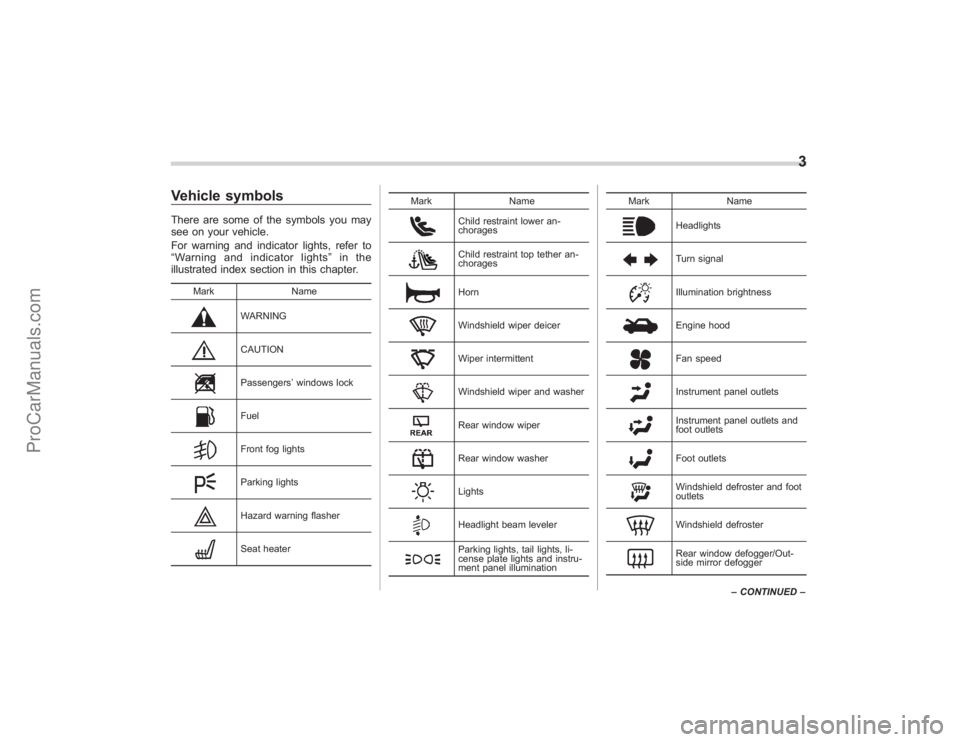
Vehicle symbolsThere are some of the symbols you may
see on your vehicle.
For warning and indicator lights, refer to
“Warning and indicator lights ”in the
illustrated index section in this chapter.
Mark Name
WARNINGCAUTIONPassengers’windows lockFuelFront fog lightsParking lightsHazard warning flasherSeat heater Mark Name
Child restraint lower an-
choragesChild restraint top tether an-
choragesHornWindshield wiper deicerWiper intermittentWindshield wiper and washerRear window wiperRear window washerLightsHeadlight beam levelerParking lights, tail lights, li-
cense plate lights and instru-
ment panel illuminationMark
Name
HeadlightsTurn signalIllumination brightnessEngine hoodFan speedInstrument panel outletsInstrument panel outlets and
foot outletsFoot outletsWindshield defroster and foot
outletsWindshield defrosterRear window defogger/Out-
side mirror defogger
3
–CONTINUED –
ProCarManuals.com
Page 25 of 409
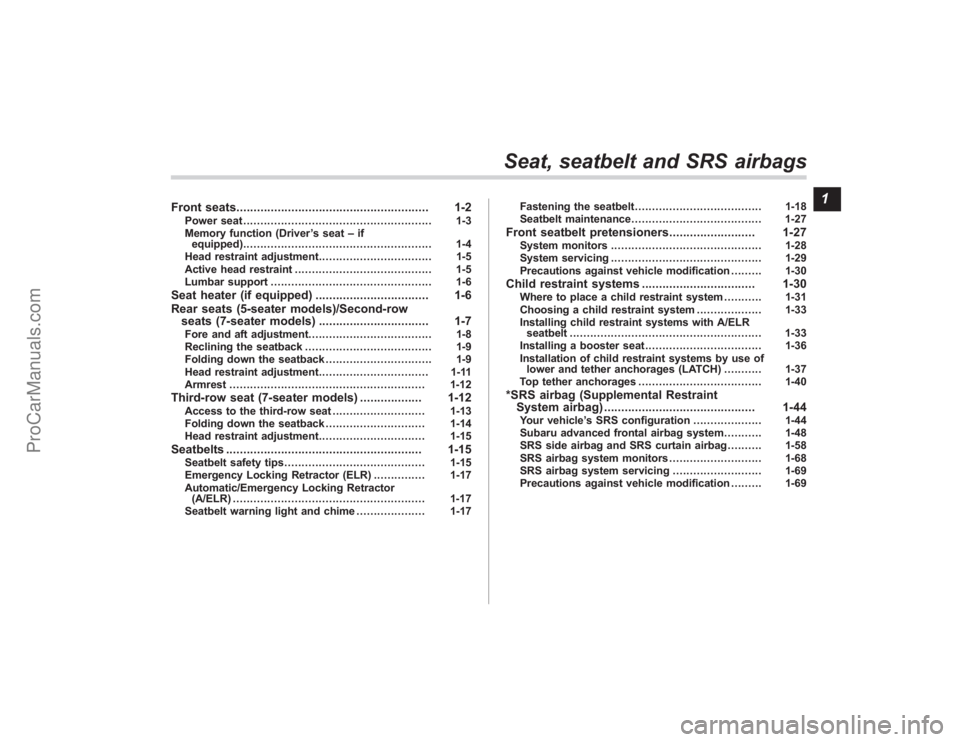
Front seats........................................................ 1-2
Power seat....................................................... 1-3
Memory function (Driver ’s seat –if
equipped) ....................................................... 1-4
Head restraint adjustment ................................. 1-5
Active head restraint ........................................ 1-5
Lumbar support ............................................... 1-6
Seat heater (if equipped) ................................. 1-6
Rear seats (5-seater models)/Second-row seats (7-seater models) ................................ 1-7
Fore and aft adjustment.................................... 1-8
Reclining the seatback ..................................... 1-9
Folding down the seatback ............................... 1-9
Head restraint adjustment ................................ 1-11
Armrest ......................................................... 1-12
Third-row seat (7-seater models) .................. 1-12
Access to the third-row seat........................... 1-13
Folding down the seatback ............................. 1-14
Head restraint adjustment ............................... 1-15
Seatbelts......................................................... 1-15
Seatbelt safety tips ......................................... 1-15
Emergency Locking Retractor (ELR) ............... 1-17
Automatic/Emergency Locking Retractor (A/ELR) ........................................................ 1-17
Seatbelt warning light and chime .................... 1-17Fastening the seatbelt
..................................... 1-18
Seatbelt maintenance...................................... 1-27
Front seatbelt pretensioners ......................... 1-27
System monitors............................................ 1-28
System servicing ............................................ 1-29
Precautions against vehicle modification ......... 1-30
Child restraint systems................................. 1-30
Where to place a child restraint system ........... 1-31
Choosing a child restraint system ................... 1-33
Installing child restraint systems with A/ELR seatbelt ........................................................ 1-33
Installing a booster seat .................................. 1-36
Installation of child restraint systems by use of lower and tether anchorages (LATCH) ........... 1-37
Top tether anchorages .................................... 1-40
*SRS airbag (Supplemental Restraint
System airbag) ............................................ 1-44
Your vehicle’s SRS configuration .................... 1-44
Subaru advanced frontal airbag system ........... 1-48
SRS side airbag and SRS curtain airbag .......... 1-58
SRS airbag system monitors ........................... 1-68
SRS airbag system servicing .......................... 1-69
Precautions against vehicle modification ......... 1-69
Seat, seatbelt and SRS airbags
1
ProCarManuals.com
Page 30 of 409
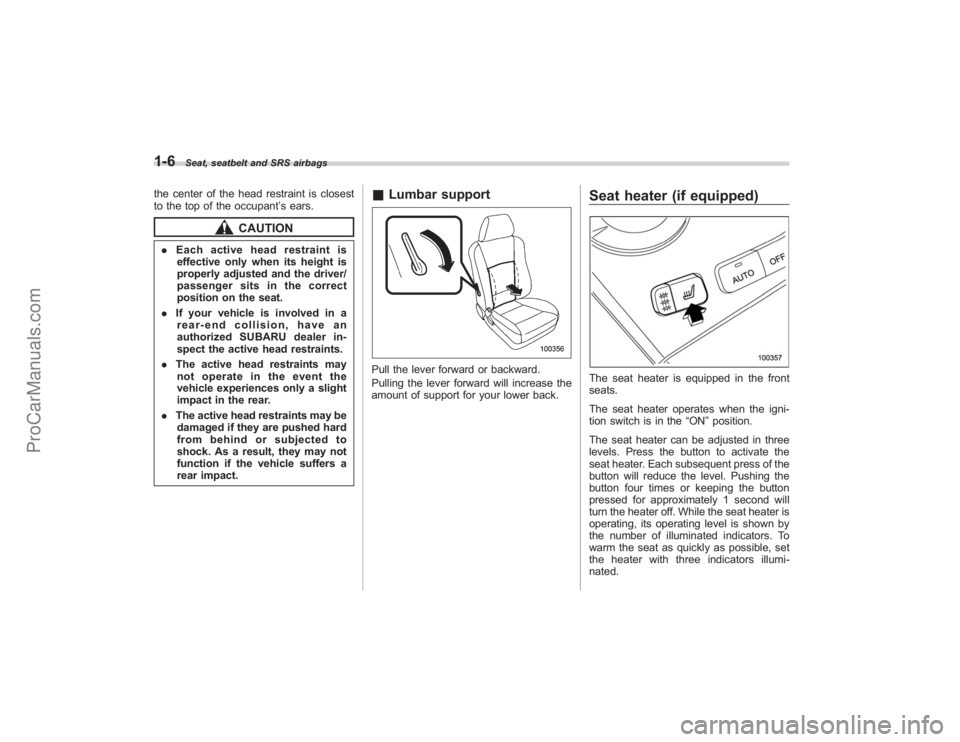
1-6
Seat, seatbelt and SRS airbags
the center of the head restraint is closest
to the top of the occupant’s ears.
CAUTION
. Each active head restraint is
effective only when its height is
properly adjusted and the driver/
passenger sits in the correct
position on the seat.
. If your vehicle is involved in a
rear-end collision, have an
authorized SUBARU dealer in-
spect the active head restraints.
. The active head restraints may
not operate in the event the
vehicle experiences only a slight
impact in the rear.
. The active head restraints may be
damaged if they are pushed hard
from behind or subjected to
shock. As a result, they may not
function if the vehicle suffers a
rear impact.
& Lumbar supportPull the lever forward or backward.
Pulling the lever forward will increase the
amount of support for your lower back.
Seat heater (if equipped)The seat heater is equipped in the front
seats.
The seat heater operates when the igni-
tion switch is in the “ON”position.
The seat heater can be adjusted in three
levels. Press the button to activate the
seat heater. Each subsequent press of the
button will reduce the level. Pushing the
button four times or keeping the button
pressed for approximately 1 second will
turn the heater off. While the seat heater is
operating, its operating level is shown by
the number of illuminated indicators. To
warm the seat as quickly as possible, set
the heater with three indicators illumi-
nated.
ProCarManuals.com
Page 31 of 409
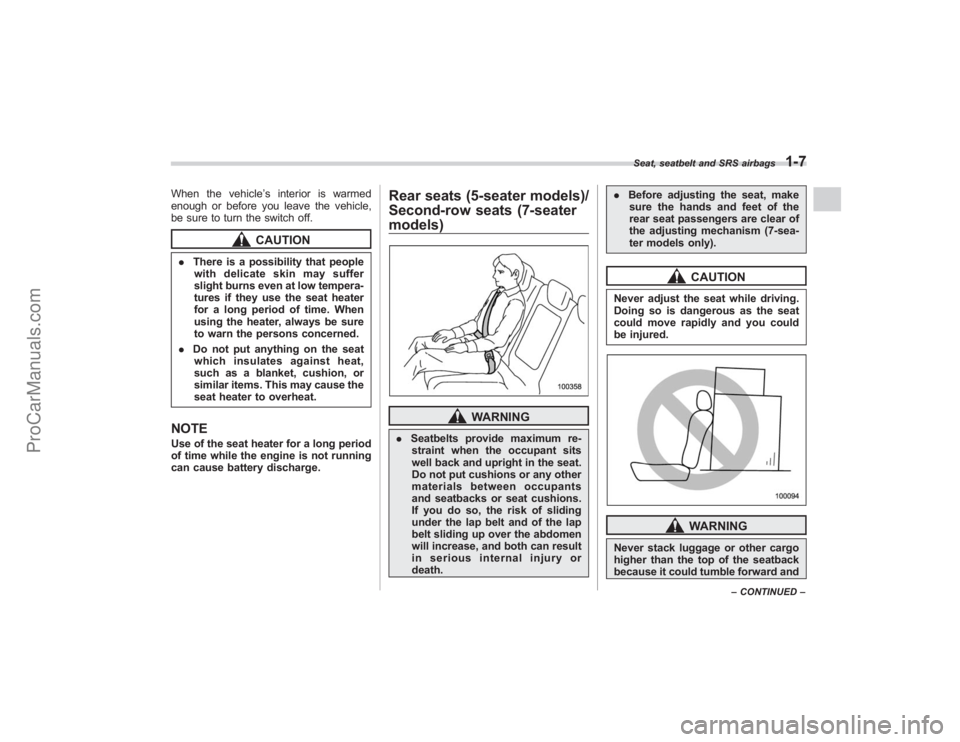
When the vehicle’s interior is warmed
enough or before you leave the vehicle,
be sure to turn the switch off.
CAUTION
. There is a possibility that people
with delicate skin may suffer
slight burns even at low tempera-
tures if they use the seat heater
for a long period of time. When
using the heater, always be sure
to warn the persons concerned.
. Do not put anything on the seat
which insulates against heat,
such as a blanket, cushion, or
similar items. This may cause the
seat heater to overheat.NOTEUse of the seat heater for a long period
of time while the engine is not running
can cause battery discharge.
Rear seats (5-seater models)/
Second-row seats (7-seater
models)
WARNING
. Seatbelts provide maximum re-
straint when the occupant sits
well back and upright in the seat.
Do not put cushions or any other
materials between occupants
and seatbacks or seat cushions.
If you do so, the risk of sliding
under the lap belt and of the lap
belt sliding up over the abdomen
will increase, and both can result
in serious internal injury or
death. .
Before adjusting the seat, make
sure the hands and feet of the
rear seat passengers are clear of
the adjusting mechanism (7-sea-
ter models only).
CAUTION
Never adjust the seat while driving.
Doing so is dangerous as the seat
could move rapidly and you could
be injured.
WARNING
Never stack luggage or other cargo
higher than the top of the seatback
because it could tumble forward and
Seat, seatbelt and SRS airbags
1-7
– CONTINUED –
ProCarManuals.com
Page 159 of 409

other similar items. Periodically wipe the
sensors clean using a piece of dry soft
cotton cloth or an applicator.
!Compass calibration
1. For optimum calibration, switch off all
nonessential electrical accessories (rear
window defogger, heater/air conditioning
system, spotlight, etc.) and ensure all
doors are shut.
2. Drive to an open, level area away from
large metallic objects or structures and
make certain the ignition switch is in the
“ON ”position.
3. Press and hold the left button for 3
seconds then release, and the compass
will enter the calibration mode. “CAL”and
direction will be displayed.
4. Drive slowly in a circle until “CAL”
disappears from the display (approxi-
mately two or three circles). The compass
is now calibrated.
5. Further calibration may be necessary
should outside influences cause the mirror
to read inaccurately. You will know that
this has occurred if your compass begins
to read in only limited directions. Should
you encounter this situation, return to step
one of the above procedure and recali-
brate the mirror. !
Compass zone adjustment
1. The zone setting is factory preset to
Zone 8. Refer to the “Compass calibration
zone” map attached to the end of this
manual to verify that the compass zone
setting is correct for your geographical
location.
2. Press and hold the right button for 3
seconds then release, and the word
“ZONE ”will briefly appear and then the
zone number will be displayed.
3. Press the right-hand button repeatedly
to cycle the display through all possible
zone settings. Stop cycling when the
correct zone setting for your location is
displayed.
4. Releasing the button for 3 seconds will
exit the zone setting mode.
& Outside mirrors! Convex mirror (Passenger side)
WARNING
Objects look smaller in a convex
mirror and farther away than when
viewed in a flat mirror. Do not use
the convex mirror to judge the
distance of vehicles behind you
when changing lanes. Use the inside
mirror (or glance backwards) to
determine the actual size and dis-
tance of objects that you view in
convex mirror.
Instruments and controls
3-39
–CONTINUED –
ProCarManuals.com
Page 163 of 409
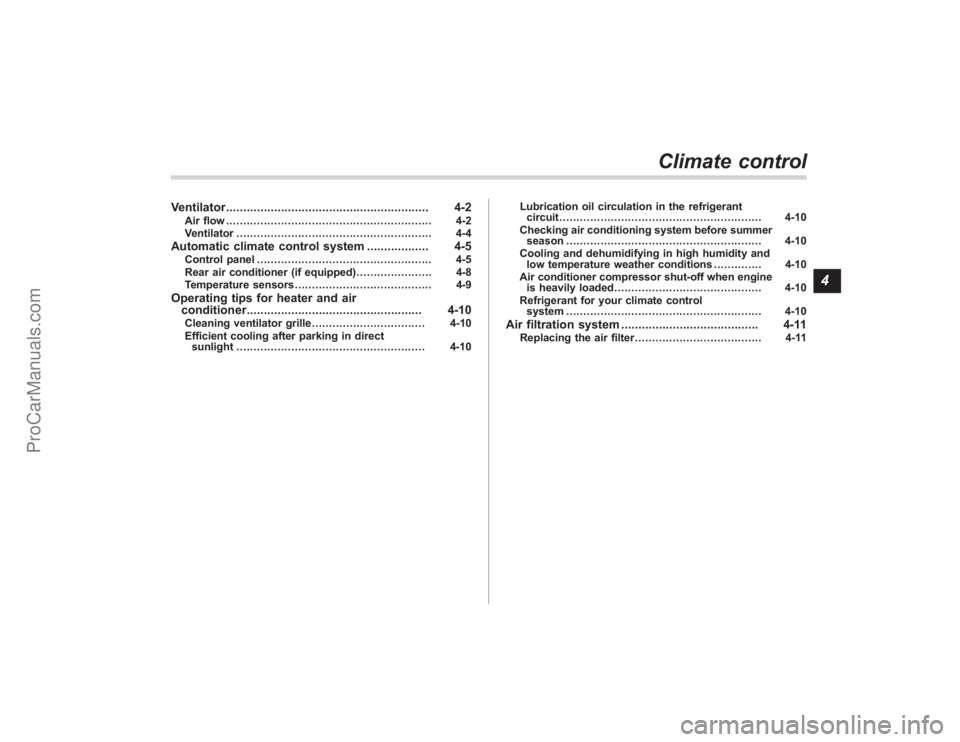
Ventilator........................................................... 4-2
Air flow............................................................ 4-2
Ventilator ......................................................... 4-4
Automatic climate control system .................. 4-5
Control panel................................................... 4-5
Rear air conditioner (if equipped) ...................... 4-8
Temperature sensors ........................................ 4-9
Operating tips for heater and air
conditioner ................................................... 4-10
Cleaning ventilator grille ................................. 4-10
Efficient cooling after parking in direct sunlight ....................................................... 4-10 Lubrication oil circulation in the refrigerant
circuit ........................................................... 4-10
Checking air conditioning system before summer season ......................................................... 4-10
Cooling and dehumidifying in high humidity and low temperature weather conditions .............. 4-10
Air conditioner compressor shut-off when engine is heavily loaded ........................................... 4-10
Refrigerant for your climate control system ......................................................... 4-10
Air filtration system ........................................ 4-11
Replacing the air filter ..................................... 4-11
Climate control
4
ProCarManuals.com
Page 171 of 409

position. The fan speed of the rear air
conditioner can be adjusted using the rear
air conditioner dial behind the center
console. The fan speed can be adjusted
in four steps by turning the dial. Turn the
dial to the“OFF ”position to stop the fan.NOTE. When the “A/C ”button is in the
“ OFF ”position and when the “A/C ”
indicator is not illuminated during
AUTO mode operation, the air condi-
tioner compressor does not operate,
meaning that the system merely blows
uncooled air out of the ventilators.
. The outlet air temperature of the rear
air conditioner cannot be adjusted.
. The rear air conditioner cannot be
used as a heater.
& Temperature sensors1) Interior air temperature sensor
2) Solar sensorThe automatic climate control system
employs several sensors. These sensors
are delicate. If they are treated incorrectly
and become damaged, the system may
not be able to control the interior tempera-
ture correctly. To avoid damaging the
sensors, observe the following precau-
tions:
– Do not subject the sensors to impact.
– Keep water away from the sensors.
– Do not cover the sensors.
The sensors are located as follows:
– Solar sensor: beside windshield
defroster grille –
Interior air temperature sensor: on the
side of the driver-side part of the center
panel
– Outside temperature sensor: behind
front grille
Climate control
4-9
ProCarManuals.com
Page 172 of 409
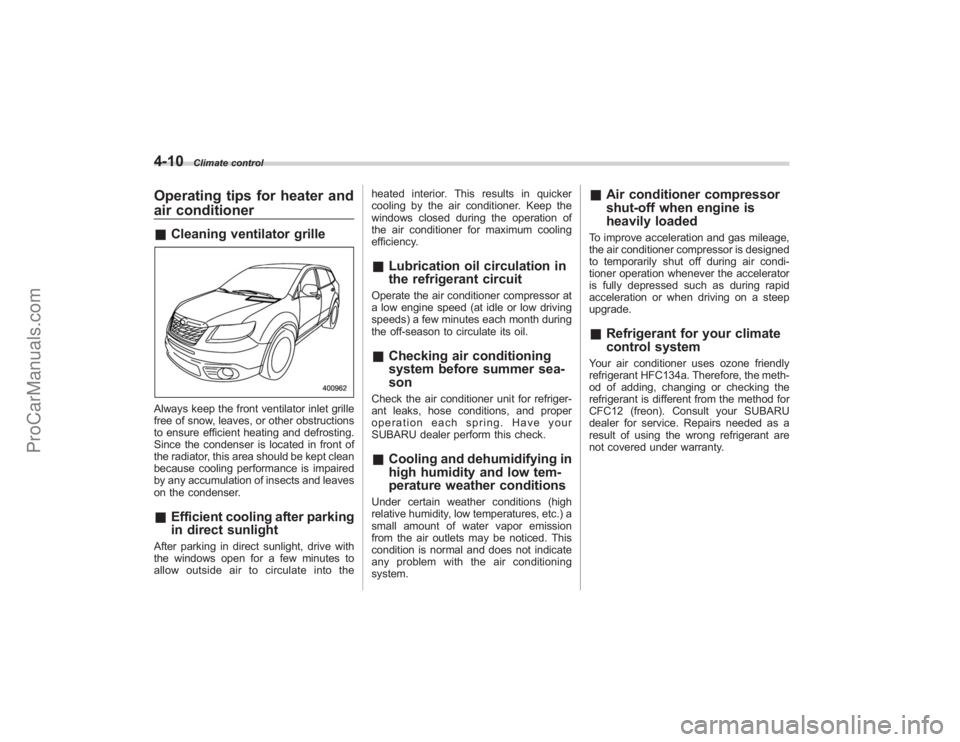
4-10
Climate control
Operating tips for heater and
air conditioner&Cleaning ventilator grilleAlways keep the front ventilator inlet grille
free of snow, leaves, or other obstructions
to ensure efficient heating and defrosting.
Since the condenser is located in front of
the radiator, this area should be kept clean
because cooling performance is impaired
by any accumulation of insects and leaves
on the condenser.&Efficient cooling after parking
in direct sunlightAfter parking in direct sunlight, drive with
the windows open for a few minutes to
allow outside air to circulate into the heated interior. This results in quicker
cooling by the air conditioner. Keep the
windows closed during the operation of
the air conditioner for maximum cooling
efficiency.
&
Lubrication oil circulation in
the refrigerant circuitOperate the air conditioner compressor at
a low engine speed (at idle or low driving
speeds) a few minutes each month during
the off-season to circulate its oil.&Checking air conditioning
system before summer sea-
sonCheck the air conditioner unit for refriger-
ant leaks, hose conditions, and proper
operation each spring. Have your
SUBARU dealer perform this check.&Cooling and dehumidifying in
high humidity and low tem-
perature weather conditionsUnder certain weather conditions (high
relative humidity, low temperatures, etc.) a
small amount of water vapor emission
from the air outlets may be noticed. This
condition is normal and does not indicate
any problem with the air conditioning
system.
&Air conditioner compressor
shut-off when engine is
heavily loadedTo improve acceleration and gas mileage,
the air conditioner compressor is designed
to temporarily shut off during air condi-
tioner operation whenever the accelerator
is fully depressed such as during rapid
acceleration or when driving on a steep
upgrade.&Refrigerant for your climate
control systemYour air conditioner uses ozone friendly
refrigerant HFC134a. Therefore, the meth-
od of adding, changing or checking the
refrigerant is different from the method for
CFC12 (freon). Consult your SUBARU
dealer for service. Repairs needed as a
result of using the wrong refrigerant are
not covered under warranty.
ProCarManuals.com